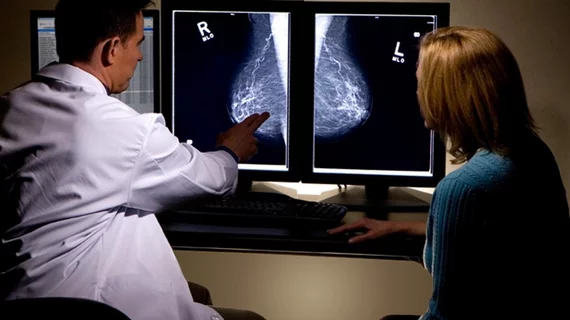Can mammography serve as a ‘dual test’ for breast cancer, CVD?
There’s a strong case to be made for mammography to become a “dual test” for both breast cancer screening and cardiovascular disease (CVD) prevention, according to a new review published in the European Journal of Radiology.
Breast cancer screening via mammography can easily detect breast arterial calcifications (BACs) which are associated with CVD and serve as an imaging biomarker for prevention of the disease, wrote Rubina Manuela Trimboli, with the department of biomedical sciences for health at the Università degli Studi di Milano in Milan, Italy, and colleagues.
“Thus, there is a strong rationale for mammography to serve as a preventive test beyond breast cancer screening, spotlighting on the heart and more comprehensively on CV risk,” Trimboli and colleagues wrote.
Trimboli et al. reviewed available evidence on the topic, finding that women with BACs have higher CVD risk than those without. Despite this, the authors found the calcifications “do not alarm radiologists” and are usually described as “present,” with little-to-no impact on CV decision-making.
Out of 18 published studies, nine reported only on the presence or absence of BAC, four used a semi-quantitative scale and five used a continuous scale. Additionally, a recent study of nearly 400 women found that more than 95% wanted their BAC reported and 107 who were unaware of their history of CVD wanted such information reported.
Is it feasible?
There are more than a few things that must be done before mammography could accurately stratify a patient’s CVD risk based on BACs, the authors noted.
For starters, there must be more evidence on the association between BACs and CVD events. That starts with an improved BAC quantification method that overcomes the “intrinsic limitation of the dichotomous assessment” which the authors called a “strong limiting factor.”
“A reliable and automated quantification of BAC is indispensable and could be the solution for contributing to the stratification of CV risk,” they noted.
A campaign to improve the awareness of BACs among radiologists, cardiologists, general practitioners and women themselves is a step in the right direction, the authors wrote.
“Preventive campaigns usually require huge efforts, both social and economic, to be implemented,” the team wrote. “In a historical phase of great attention to the healthcare expenditure, to work in favor of using BAC for CV prevention in women, using the infrastructure of an already existing screening, implies that important results could be obtained with relatively limited costs.”

